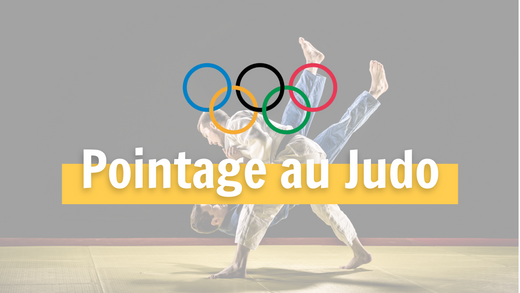
Olympics: How to count points in Olympic Judo
Pascal CadoretteOlympics: How does the Judo scoring system work?
You are watching the Olympics, but one thing catches your attention: What do the little yellow rectangles next to the score mean? Why do some athletes win when they take an opponent to the ground and why do some not win, but have 1 point? What does the "Golden Score" mean? What is a Waza-ari? What is an Ippon? What is a Shido? Why do some athletes receive penalties?
In this blog post I explain absolutely everything you need to know to understand the Judo scoring system at the Olympics so you can watch judo and understand everything!
What is the Olympic Judo ?
In Olympic Judo , the rules are a little different than traditional Judo competitions. So, it is necessary to understand how points, penalties, decisions, etc. are counted.
In Olympic Judo, fights take place in one round (instead of three), and points are awarded based on various actions performed during the fight. The main objective of each judoka is to throw the opponent to the ground with force. With force, remember this! By managing to throw the opponent to the ground, with force, the judoka wins a Ippon and wins the match.
Judokas can score points by performing spectacular throws or by immobilizing their opponent on the ground for a certain amount of time. Each action has a specific value, and points are accumulated throughout the fight to ultimately form an Ippon (we'll come back to that!)
It is important to understand how points are scored in Olympic judo, as this can influence the strategy and tactics used by judokas. A few well-placed points can mean the difference between victory and defeat.
The rules of the Olympic Judo
Olympic judo is governed by a strict set of rules that ensure fair and safe play for all participants. These rules are established by the International Judo Federation (IJF) and are enforced during the Olympic Games.
One of the main rules of Olympic judo is that the fights take place in a single round lasting 5 minutes. If neither judoka scores a decisive point during the round, the fight goes into overtime, which is called the Golden Score . In Golden Score , the first judoka to score a point is declared the winner.
The goal of the Judokas is to earn an Ippon (1 point). To earn an Ippon, the Judokas must throw the opponent to the ground with force, immobilize him on the ground for 20 seconds or complete a submission which is either a choke or an arm lock. All of the above elements allow them to earn an Ippon. If the Judoka throws the opponent, but with little force, he earns a Waza-ari , half a point. 2 Waza-ari are needed to form an Ippon.
A Waza-ari can be gained by pinning your opponent to the ground for 10 seconds (instead of 20).
It is also important to note that Olympic judo is a limited contact sport. Holds and throws must be performed with control and precision, so as not to cause serious injury to the opponent. Any action that endangers the physical integrity of the opponent may result in disqualification.
Finally, judokas must adhere to a strict moral code during fights. Respect for the opponent, sportsmanship and ethics are fundamental values of Olympic judo. Judokas must greet each other before and after the fight, thus showing their mutual respect.
Then, you have to be careful because during the match, the referee can issue certain penalties called Shido, these are the little "Yellow Cards" that we see. These are penalties that are awarded if a judoka slows down the fight, shows passivity, makes false attacks, etc.
What is the point system in Olympic Judo ?
The Olympic judo scoring system is based on the execution of different actions during the fight. There are several ways to score points, but the two main ones are throws and immobilizations.
Throws are techniques in which a judoka throws his opponent to the ground with force and control. Depending on the quality of the throw and how the opponent lands, different points are awarded. A successful throw can earn a judoka an Ippon, which immediately ends the fight. Half points, called waza-ari, can also be awarded for less spectacular throws.
Holds are techniques in which a judoka manages to keep his opponent on the ground for a certain amount of time. If a judoka manages to keep his opponent on the ground for twenty seconds, he is awarded a full point, or ippon. If the hold lasts less than twenty seconds, a half point, or waza-ari, is awarded. It is important that the opponent is immobilized on the ground, with his back resting on the ground.
- Ippon: A full point that wins the match. It is obtained by throwing your opponent to the ground with force and control or by immobilizing the opponent on the ground for 20 seconds.
- Waza-ari: Half a point. 2 Waza-ari are needed to win a match. During an overtime period (Golden Score), only one waza-ari is enough to win. Obtained with a less spectacular throw or by immobilizing the opponent on the ground for 10 seconds.
When throwing, it is important to observe how the opponent falls. If he falls directly on the back (the shoulders touch the ground) then the fall is judged much more significant and triggers generally an Ippon. If the opponent falls on one shoulder (what is called the slice ), then it is usually noted as a Waza-ari, since the opponent did not fall completely on his back.
The different techniques of projection and of submission.
In Olympic judo, judokas must master several throwing and submission techniques to score points. This is also what makes one of the great distinctions of Judo: the spectacular projections!
Here are some of the most commonly used techniques in Judo:
- The Osoto-gari: In this throwing technique, the judoka uses his foot to mow down his opponent's leg, causing him to fall on his back.
- Ippon-seoi-nage: This technique involves grabbing the opponent's backhand and throwing him over the shoulder.
- Uchi-mata: in this technique, the judoka uses his leg to lift his opponent and throw him forward. One of the typical projections of judo!
- The Armlock: It is a submission technique in which the judoka immobilizes his opponent's arm by twisting it in an uncomfortable position. In Jiu-Jitsu, this submission is often referred to as an Arm-Bar, you can find an example in this article: 10 Most Common Submissions in Jiu-Jitsu
These techniques are just a few examples of many used in Olympic judo. Each judoka develops his or her own style and preference based on his or her skills and body type.









